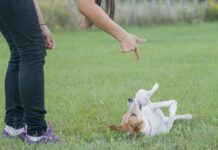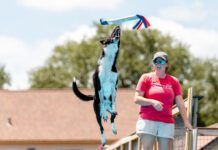[Updated February 7, 2019]
BEGINNING DOG PARKOUR OVERVIEW
1. Visit the International Dog Parkour Association’s website to learn more about this fun sport.
2. Explore new areas with your dog. Be creative! Encourage your dog to interact with the environment while practicing basic obedience and parkour skills.
3. Once your dog understands what to do with a certain obstacle – whether that’s jumping over, running under, or jumping up on it – see if you can “send” him to perform the same exercise from a distance.
4. Ask for more challenging behaviors only as your dog tells you he’s ready. Be patient while working on new behaviors – and remember to always keep it fun!
The tiny terrier confidently ascends the park bench at her handler’s request while the sun shines down on a warm Southern California day. There she sits, clearly enjoying the interaction with her human, and happily cooperating with the task at hand. The treat she’ll earn after hearing her release word isn’t bad, either.
For Delilah and Elisa Becker of Simi Valley, California, and countless teams like them, this type of activity transcends being a creative way to add pizzazz to a daily walk – they’re working toward a title in a fun new sport: dog parkour.
Parkour for Dogs: Fairly New, Very Fun
Dog parkour is the Fido-friendly version of parkour, sometimes called “free running,” a type of outdoor gymnastics. In the human version, enthusiasts (called “traceurs”) run, climb, leap, and swing their way through an improvised course of obstacles in the environment. Success in parkour is about discipline, not just daredevil tendencies; safety is of the utmost importance, and participants take great care to develop proper cardiovascular conditioning, strength, and body awareness.
Stephanie Colman

The sport “went to the dogs” in 2014, when established traceurs and dog trainers Karin Coyne and Abigail Curtis, DVM, of Reynoldsburg, Ohio, noticed how many unique obstacles in their everyday environment were accessible to dogs. They started experimenting with their own canine companions and quickly added parkour-themed classes to their training offerings. From there, the International Dog Parkour Association, (abbreviated IDPKA, since traditional parkour is often referred to as “PK”), and a new titling sport was born.
Coyne says dog parkour is a great way to get any dog-handler team out of the house, but it’s an especially nice option for owners whose dogs struggle with reactivity in a traditional group setting, or in areas where group classes are few and far between.
“For us, one of the best things about dog parkour is how it helps improve a dog’s confidence and focus as they explore new things,” Coyne says. “For the people, it gets them out, too. A lot of owners wouldn’t investigate a neighborhood park on their own, but once they start parkour, they’re looking for new areas to explore.”
Dog Parkour Rules and Requirements
Dog parkour involves a variety of skills, which must be executed in increasingly difficult ways in order to earn progressive titles.
Conceptually, the most common behaviors require putting four feet on an object, four feet in an object, jumping over an object, passing through a gap in or between objects, balancing on narrow objects, and moving away from the handler to go around an object.
It may sound easy, but Becker says even the seemingly simple concepts helped uncover some “holes” in her training.
“I took for granted that, because Delilah is constantly jumping up on things on her own, she’d know what I meant when I asked her to ‘jump up,'” Becker says. “I also discovered she didn’t like jumping into things. The ‘four feet in’ behavior was initially the hardest for us. I wasn’t expecting that.”
The IDPKA currently offers five titling options ranging from a training-level title (PKD-T) to a championship title (CH-PKD), all awarded based on a thorough review of handler-submitted videos and an accompanying submission fee of $20 to $40.
“I love being able to video our work and submit for a title,” Becker says. “It makes me less nervous, and gives us a chance to practice first and submit the best version of the performance. The only challenge with video is making sure we both stay in frame and I’m not blocking the camera.”
Traditional dog sports such as obedience, rally, and agility specify exactly how required elements must be executed, but dog parkour requires creativity and an eye for the environment, wherever you are – whether in a city or rural landscape. Park benches, utility boxes, playground equipment, tree stumps, decorative railroad ties, and more can easily become part of the parkour experience. How exactly your dog executes a “four feet on” behavior is limited only by your imagination, safety considerations, and your dog’s willingness to perform as requested.
“It’s creative and completely adjustable,” Coyne explains. “A young dog or older dog might put his feet on a six-inch obstacle; other dogs train for more of a challenge. Every dog can participate in some way.” Required elements can even be modified to allow for the safe and confident participation of dogs with disabilities.
To date, IDPKA has awarded nearly 250 titles to teams, mostly at the novice level. While the majority of title-holders hail from the U.S., teams from Canada, Denmark, United Kingdom, Sweden, and Australia have also completed title requirements.
Safety Comes First in Canine Parkour
Safety and choice – on the part of the dog – are at the heart of IDPKA’s program.
“If you try to force or lure or do anything to make the dog feel like he has to perform a behavior, it can become dangerous, because the dog isn’t freely choosing to participate,” Coyne says.
“It’s important to emphasize choice, start small, and work your way up. At the novice level, things are small – ground level. The dogs build strength and coordination, and the handler learns to properly ‘spot’ the dog to make sure he remains safe throughout the exercise.”
That’s not to say training lures are completely discouraged in all aspects of dog parkour. Coyne acknowledges how, in a team’s early training, lures can be helpful in establishing a dog’s understanding of conceptual behaviors such as “jump up” or “go under.”
“It’s one thing to lure a new dog up onto a low rock when first training,” she says. “But by the time a handler is ready to ask her dog to jump atop a tall wall, the dog should understand the cue and feel confident in his ability.” To that end, once working on a title submission, food or toys can be used only as rewards following the successful completion of a behavior, not to initiate or guide behavior.
In promoting the safe execution of urban obstacles, dogs must wear well-fitting back-clip harnesses, and handlers must make responsible decisions regarding the choice to work on- or off-leash, depending on the environment.
Dogs are never allowed to jump down onto a hard surface from higher than shoulder height. Instead, they must be carried, lowered, or shown an alternate exit strategy. Submission videos must clearly show the dog ascending and descending each obstacle. Handlers must demonstrate an understanding of proper spotting in order to assist their dogs as necessary. Most importantly, dogs must perform all obstacles independently, of their own free will, and with confidence.
“We like to see dogs who are confident, who understand where their feet are, and who are in a situation where, if something happened, the handler could immediately help,” says Coyne.
When a submission fails to pass, it’s usually for safety reasons – either the handler allowed a dog to jump down from a height exceeding safety guidelines, the handler wasn’t in a position to properly spot the dog, or the dog looks uncomfortable while performing the obstacle.
Expanding Your Dog’s Horizons with Sport
As a trainer, I’ve always been a fan of incorporating elements found in the environment into my daily dog walks. Random objects are great for helping dogs generalize behaviors while adding novelty to otherwise routine outings. For many people, the opportunity to work toward a title provides the motivation they need to brainstorm new things to train. Of course, time spent training strengthens the dog-human relationship, while helping to create and maintain a well-trained dog who is a joy to have around.
With the growing popularity of dog parkour, a little creativity, a video camera, and the Internet can help turn any dog into a titled urban athlete! Best of all, Elisa says, “It’s fun. That’s exactly how I feel all training should be – fun. If the dog isn’t having fun, there’s no reason to do it.”
Our thoughts exactly.
Things Whole Dog Journal Loves About Parkour for Dogs:
- If it seems that coercion or force was used to get the dog to perform an exercise, the performance will not be awarded with a title.
- Safety is stressed at every level. Strength and coordination are built slowly. The handler has to know how to and be able to support and catch the dog, preventing falls.
- Dogs who look confident and in control of their movements do well; wild attempts at exercises will not earn titles.
- Handlers don’t have to travel to events to earn titles; video submissions are judged instead.
Stephanie Colman is a writer and dog trainer in Southern California.





